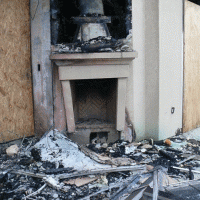As the weather turns cold, many people use fireplaces to provide supplemental heat. The warmth from a fireplace is a comfort and the aesthetics of a glowing fire are a pleasure. However, there is nothing pleasurable about a residential house fire that results from an improperly built or used fireplace or chimney.
Every year Warren investigates fires that occur during the use of fireplaces. In some cases, improper construction of the fireplace or chimney caused the fire. Warren was involved in the investigation of one such fire that was alleged to have been caused by an improperly built hearth extension. The hearth extension of a fireplace is the portion of the assembly that extends out in front of the fireplace interior.

Figure 1: A view of the improperly constructed fireplace alleged to have caused the subject fire.
The hearth extension has been largely consumed in the fire.
Enough of the hearth extension was found to determine that it was built of dimensional lumber and plywood with a stucco exterior. This construction was clearly in violation of both the International Residential Code and NFPA 211: Standard for Chimneys, Fireplaces, Vents, and Solid Fuel-Burning Appliances. However, just because the construction was in violation of a code or standard does not establish causation of the fire. To answer the question of the effect of the improper construction, Warren built and tested an exemplar fireplace to include the improperly built hearth extension.

Figure 2: A view of the interior of the testing fireplace and hearth extension. The assembly was constructed with 40 imbedded and exterior thermocouples (temperature sensors) connected to a data logger.
The exemplar wood fired fireplace and chimney were made with the same modular masonry fireplace and manufactured metal chimney system that was used in the subject house. The wooden structure that housed the fireplace was framed in the same manner as the original. A SolidWorks 3D CAD model was made of the assembly. Several trials were ran with slightly varied geometry that used the same quantity of wood per amount of time as had been burned in the fireplace at the time of the incident. A graph of recorded temperatures during a test is shown in Figure 3. Many temperatures are above the UL 127 limit of 90F above ambient. Some of the temperatures are well above the NFPA 921 minimum short term ignition temperature of wood. The results of our testing showed that the wood framing of the hearth extension in the area close to the firebox reached temperatures that could result in ignition.

Figure 3: A graph of wood temperatures in one of the tests. Several temperatures are above generally agreed ignition temperatures for wood.
Founded in 1997, The Warren Group, forensic engineers and consultants provides technical investigations and analysis of personal injury and property claims as well as expert testimony for insurance adjusters and attorneys. Extremely well versed in the disciplines of mechanical, electrical, chemical, structural, accident reconstruction and fire and explosion investigation, our engineers and consultants are known for delivering the truth — origin, cause, responsibility and cost of an event or claim — with unmistakable clarity.



